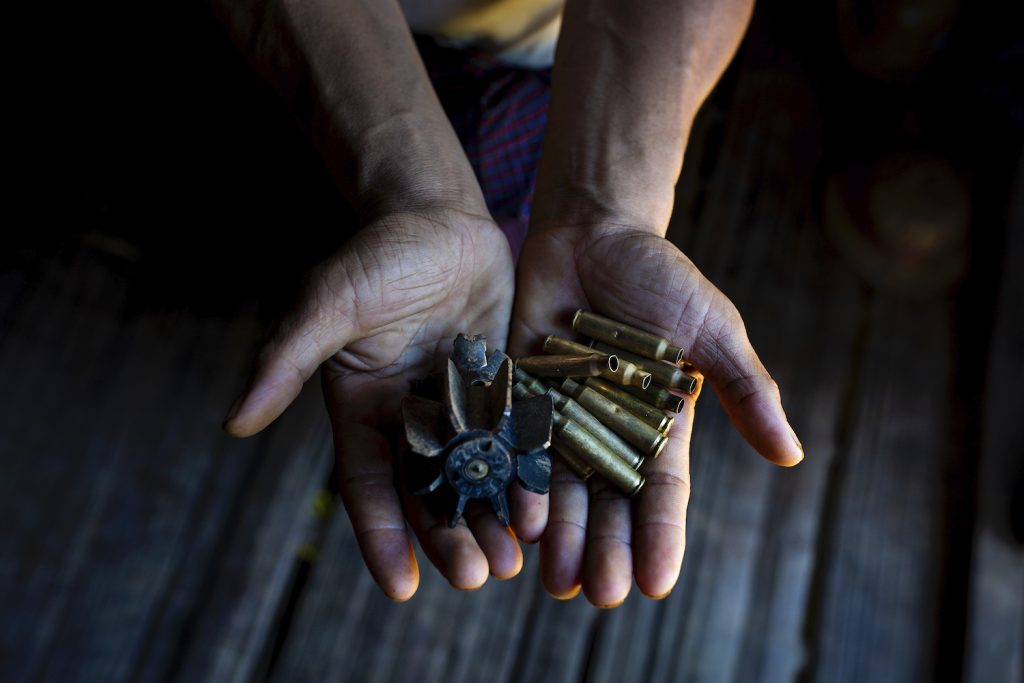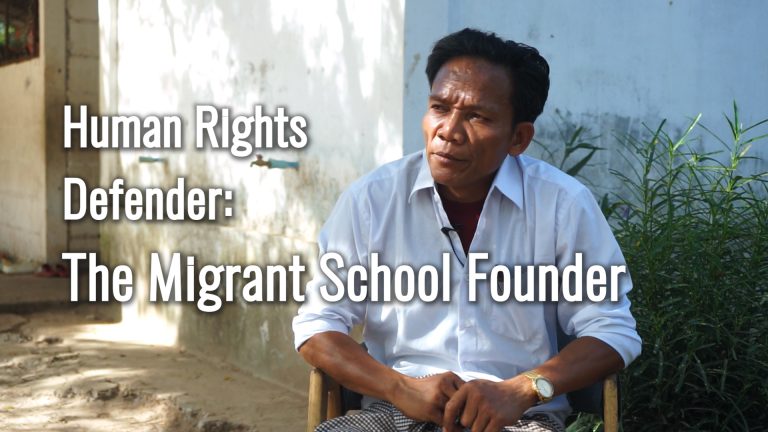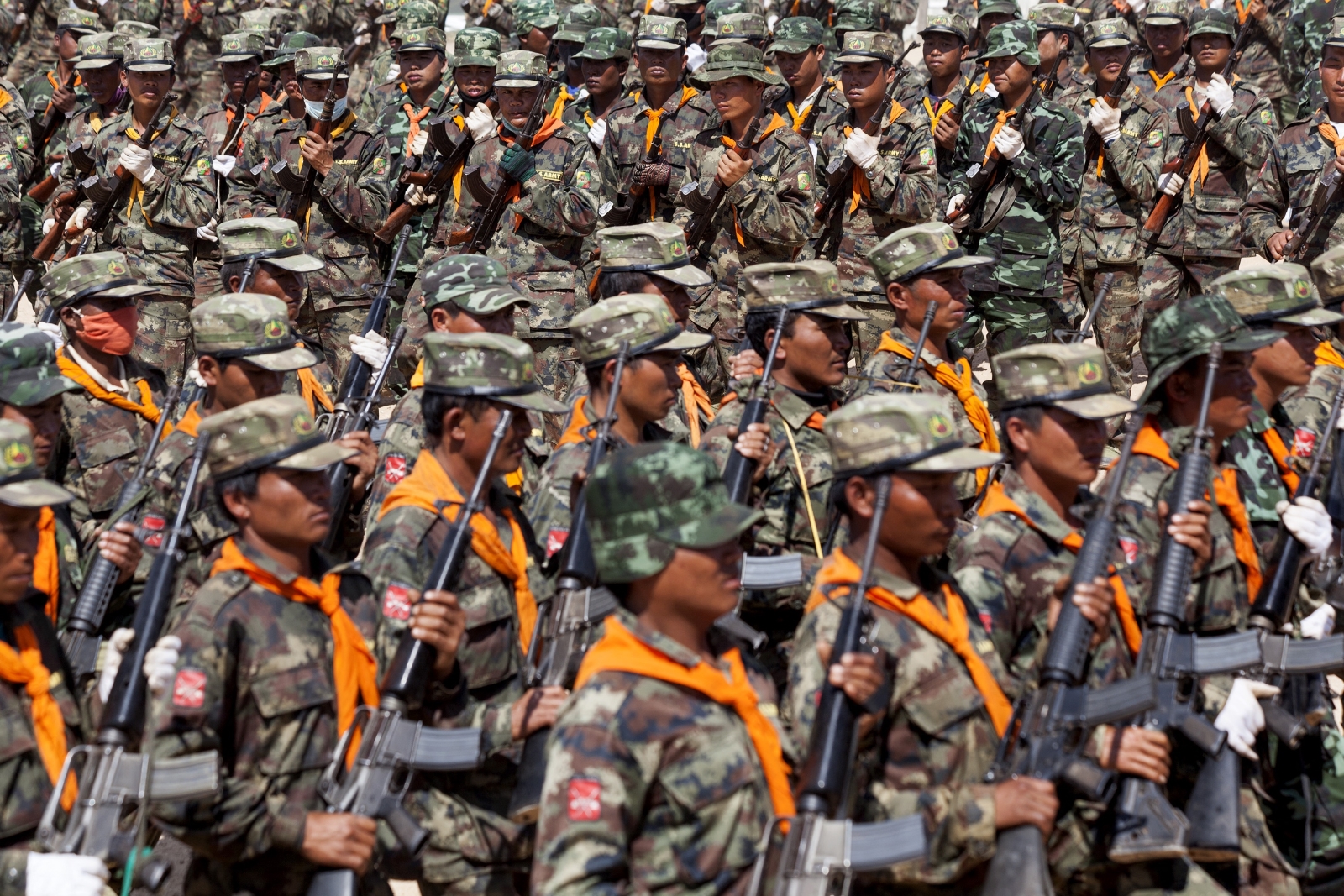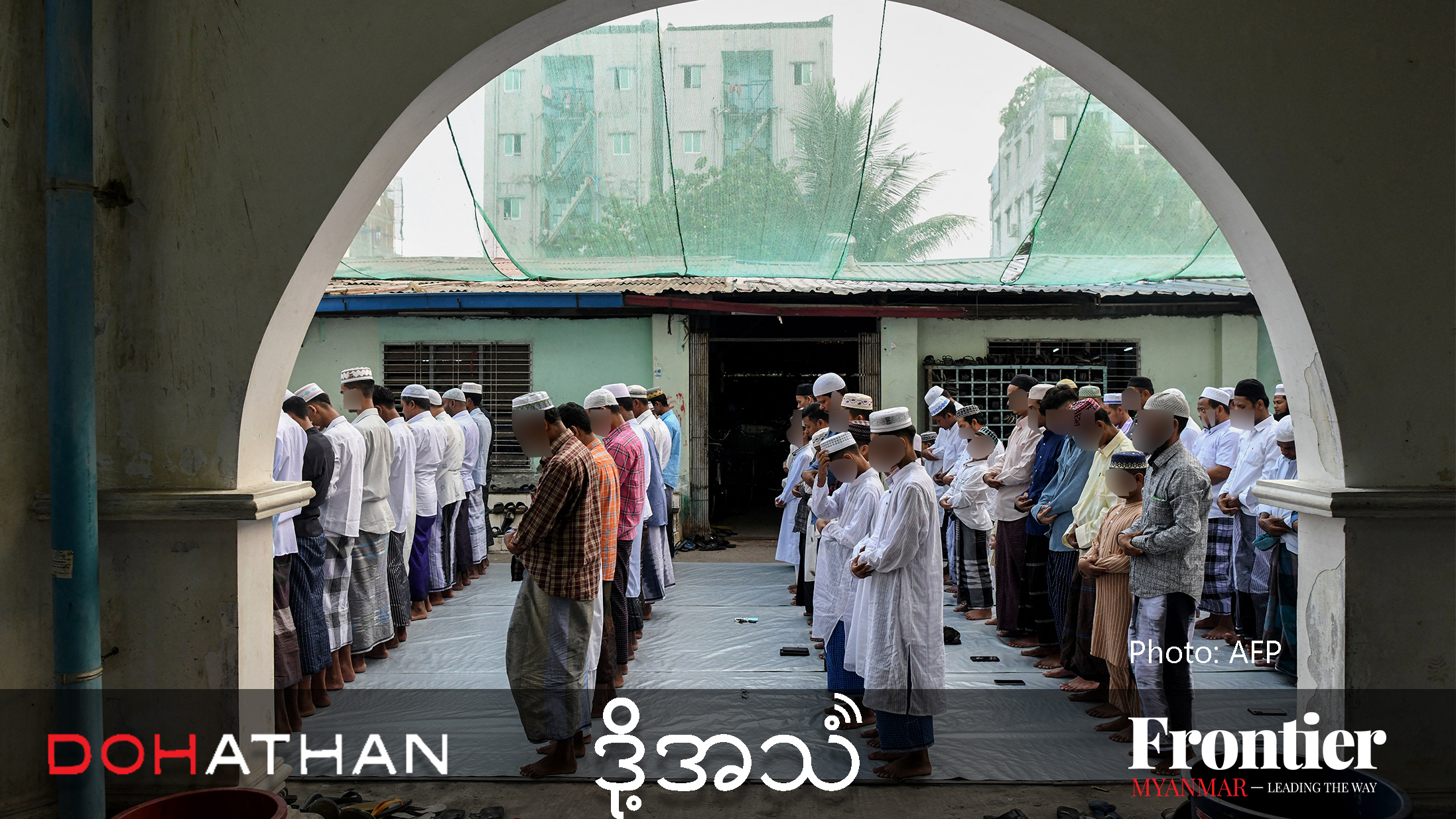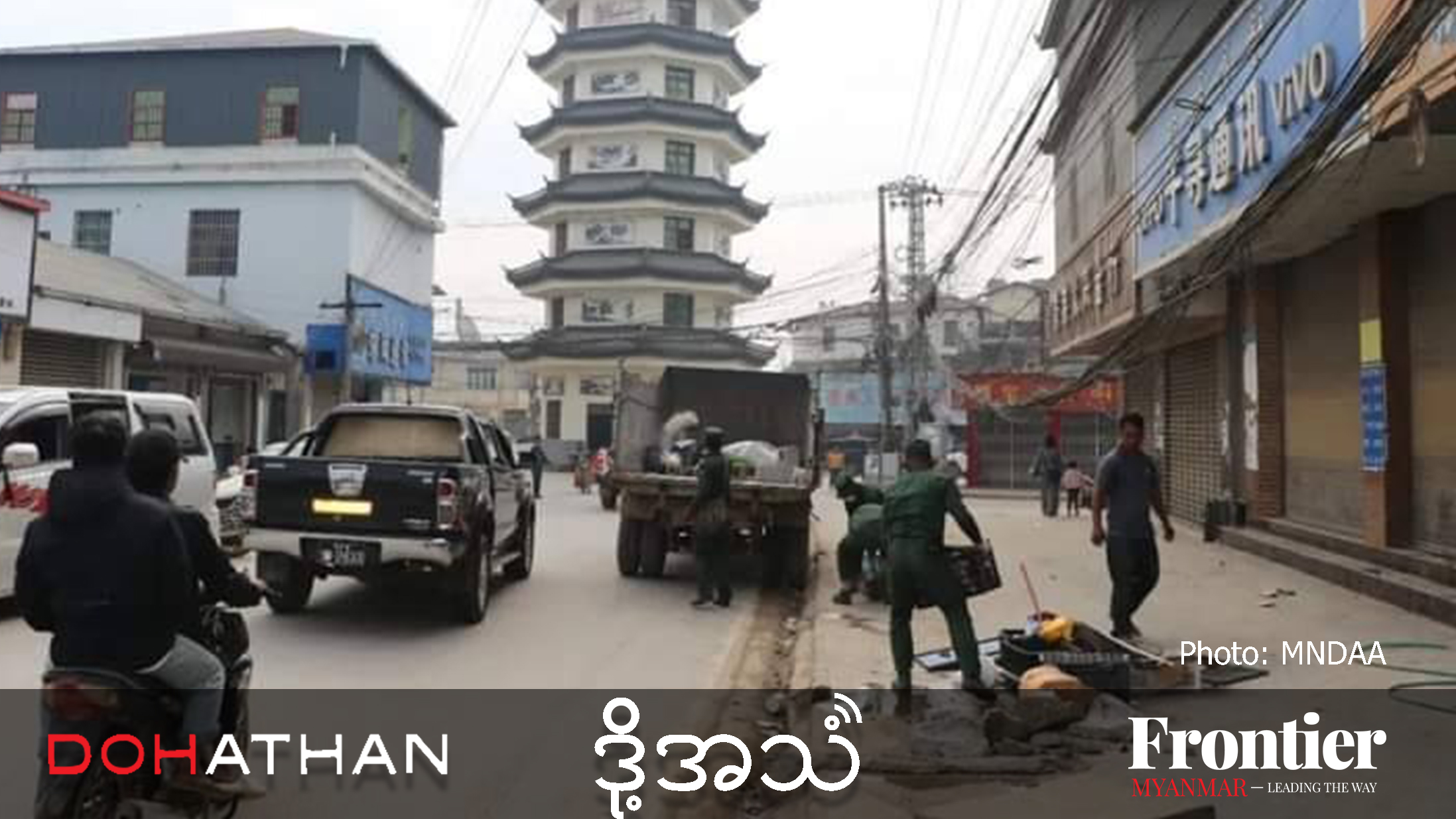For years, residents of a conflict-blighted area of Shan State had ‘kept their anger inside’, but after the Tatmadaw gunned down a farmer, more than 10,000 villagers marched in protest.
By HEIN THAR and ANDREW NACHEMSON | FRONTIER
When Nang Shwe recalls the morning her husband was killed by the Myanmar military, she speaks of her regret.
“That morning we talked about going to the farm to separate the corn. I wish we had gone because then we could have escaped, but we were afraid of the Tatmadaw soldiers,” she said.
It was June 29, and they knew soldiers were patrolling in the area. In recent days there had been several clashes between government forces and the Shan State Army-South, the armed wing of the Restoration Council of Shan State.
Nang Shwe and her husband, Loong Hsu, thought they would be safer in the village than going out to the farm. They certainly didn’t expect the Tatmadaw to open fire on civilian houses.
“When we first heard the sound of gunfire, I said we should stay in the house and hide, but he refused and said we should run to the school because it is a safer building made of concrete,” Nang Shwe remembered.

It was a reasonable suggestion. The homes in Pang Kyin village are mostly made of thatch and thin wood, which bullets can penetrate easily. As Nang Shwe and Loong Hsu fled to the school, the home of a neighbour, Nai Hsai, was ripped apart by gunfire.
Frontier saw at least half-a-dozen bullet holes in the walls of Nai Hsai’s home. One had hit a cooking pot; another had shattered her solar panel.
“When the soldiers came to the village, a young woman shouted that the Tatmadaw is coming,” she said. Like Nang Shwe and Loong Hsu, Nai Hsai was aware that troops were in the area. She had packed a small bag the night before in case she had to quickly flee. But when she went to grab it, a bullet tore through her house and struck her in the hip.
Initially too shocked and terrified to feel the pain, she managed to walk with help from one of her grandchildren to nearby Yae Hsan village. From there, she was taken by car to a nearby hospital. The bullet had passed through her leg and healthcare workers were able to stem the bleeding, saving her life.
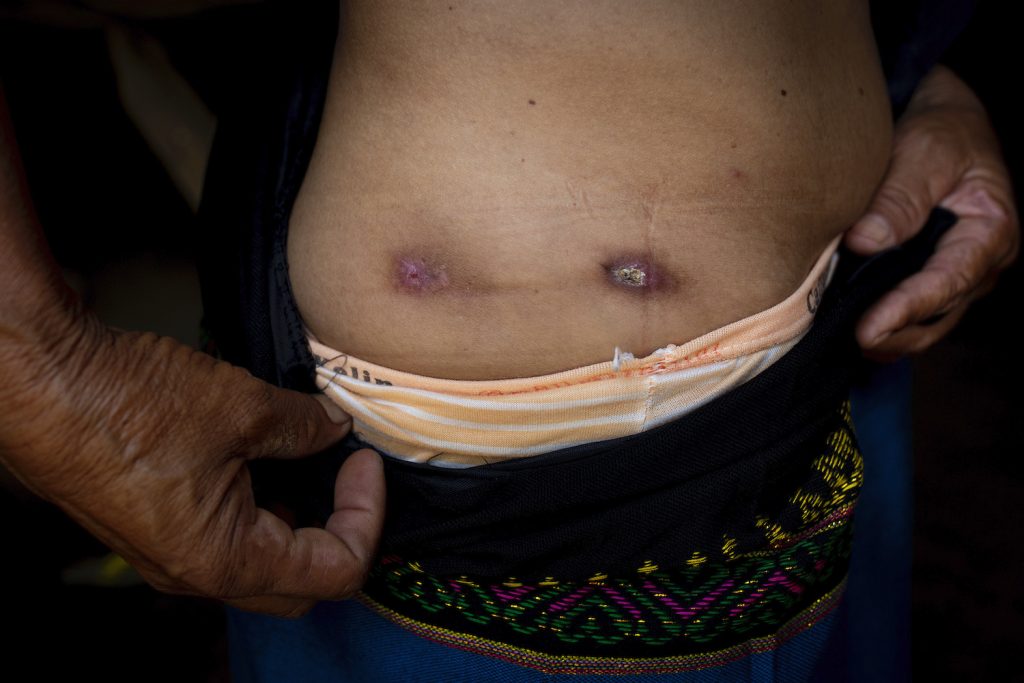
Back in Pang Kyin village, Nang Shwe, Loong Hsu and her aunt hunkered down in a concrete room at the school. Two soldiers banged on the door, demanding that they open it.
Nang Shwe recalled these events while sitting on the floor of the monastery where she and Loong Hsu had first met, 35 years earlier. They were students – she was 19 and he was 24. She had come from neighbouring Wo Long village to study in Pang Kyin, as many in the area did. They married soon after and lived in Wo Long, where Hsu eventually served as a village chief and they had six children.
But the eruption of brutal fighting in 2016 took a harsh toll on Wo Long, with villagers killed and homes burned as the Tatmadaw shelled the area and shot down from helicopters. After the fighting subsided, Nang Shwe and Loong Hsu moved back to Pang Kyin, where they hoped for a fresh start.
The day the Tatmadaw opened fire on the village, Loong Hsu was 59. He was dressed in civilian clothes. Nang Shwe said her husband was just an “honest” and “ordinary” corn farmer. Because he had no connection to the RCSS, she said, they had no reason to believe the Tatmadaw soldiers would hurt him.
But when Loong Hsu opened the door, they shot him. Trying to escape, he stumbled out of the room into a field, where the soldiers shot him twice more, killing him.

Loong Maung Khay was standing on the road, about 10 metres from where Loong Hsu was shot dead. He had been detained by the Tatmadaw earlier that day and ordered at gunpoint to guide them to Pang Kyin.
“The soldiers asked me if there was a man in the school. I said there was no man in there because I didn’t know, but when they found U Hsu, they beat me,” Maung Khay said.
Maung Khay quickly lost consciousness. He woke later in a small pond, where he presumes the Tatmadaw dumped his limp body, and spent the next five days recovering in Kyaukme’s hospital.
“I still have trouble eating because my jaw is injured,” he said, opening and closing his mouth gingerly in demonstration.
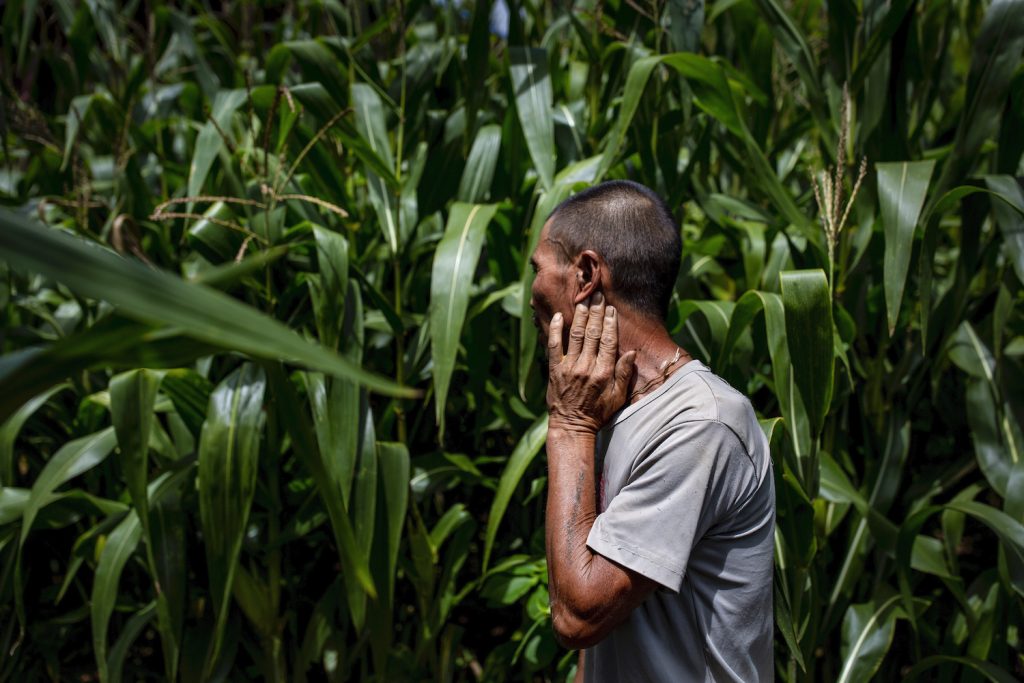
The attack on the village took place against the backdrop of increased tension between the Tatmadaw and RCSS, and other ethnic armed groups in the region. From June 25 to July 21, the Shan group claims to have clashed with the Tatmadaw at least 20 times.
Although Frontier did not see any Tatmadaw troops in the villages during the trip, we did pass two large military convoys on the Lashio-Mandalay highway, indicating a heavy presence in the area. The first convoy was seen about 32 kilometres from Hsipaw town, where there has also been recent fighting. Roughly 12 trucks were stopped on the side of the road with about 15-20 troops in each vehicle.
After leaving Kyaukme Township, Frontier passed another convoy, smaller than the first but more heavily armed. About 10 cars carrying five or six soldiers snaked through the mountainous switchbacks near Nawngkhio Township. Some of the cars had been modified and were mounted with turrets.
Frontier did encounter at least two RCSS soldiers in Pang Kyin village. After we had been conducting interviews for about three hours, two young men arrived and began listening in on conversations and following us around town. We were later told by villagers that they were RCSS soldiers sent to observe us, but they did not interfere with our work.
Although the conflict spans decades, U Sannimar, a monk in He Kwi village, said the recent trouble began with a drug burning ceremony. Every year on the International Day Against Drug Abuse and Illicit Trafficking, on June 26, the Tatmadaw makes a spectacle of burning drugs it has confiscated. This year was no different, except on a bigger scale than normal: the security forces burned more than US$800 million worth of drugs in several cities across Myanmar, including three places in Shan State.
The RCSS planned its own drug burning ceremony in Kyaukme, which the Tatmadaw apparently felt was a challenge to its authority. Adding flames to the fire, the RCSS put up posters claiming that many of the drugs it planned to destroy had been confiscated from soldiers and police officers, said Sannimar.
One local resident with close ties to the Tatmadaw, who spoke on condition of anonymity, told Frontier that the RCSS had used the drug burning ceremony as an excuse to increase its presence in the area. He claimed the armed group sent 500 soldiers into Kyaukme for the event, far more than was necessary.

The Shan Human Rights Foundation sees a nearby controversial development project, the Upper Yeywa hydropower dam, as the root cause of increased tensions. “These latest violations also highlight the deadly collateral impact of large-scale resource extraction and infrastructure projects in Burma’s conflict zones, which are secured by the abusive, unaccountable Burma Army,” the group said in a statement.
The RCSS liaison officer in Kyaukme, Ma Nan Moe, said the armed group “tried to avoid fighting”, but the Tatmadaw came into its territory unannounced. Despite the current tension, she said the RCSS, a signatory of the Nationwide Ceasefire Agreement, still intends to attend the upcoming Panglong peace conference planned for August 19-21.
“We really want peace and hope this case will not affect the peace process,” she said, calling the recent fighting a “misunderstanding”.
Still, she warned the Tatmadaw not to make the same mistake, or the RCSS would not hesitate to fight again. “If the Tatmadaw comes into the forest or our area without informing our liaison office in Kyaukme, there will be more fighting,” she said.
Sannimar said the military and RCSS engaged in their first small skirmish on June 25, after they failed to reach an agreement on the planned drug burning ceremony. When the RCSS went ahead with the event the next day anyway, the Tatmadaw’s presence in the area quickly increased, and so did the fighting. Soldiers arrived in He Kwi and began calling in villagers to question them about the drug burning ceremony.
“They stayed for three nights. Every day in the morning, they went out and fought with the RCSS and then came back here to sleep,” Sannimar said. “One day a bullet even hit the monastery. I took the bullet and confronted them and asked, ‘Do I need to flee?’ But they said there is no danger here.”

After the attack in Pang Kyin village and the killing of Loong Hsu, thousands turned out to protest. A large crowd of demonstrators – estimates range from 10,000 to 15,000 – marched from their villages into the town of Kyaukme on July 10, where authorities initially tried to prevent them from entering, before eventually relenting.
Kyaukme residents had a variety of reasons to explain why Loong Hsu’s killing provoked such a strong reaction. “There was no apology or investigation so if we did not protest, nobody would know the military was violating human rights like this,” said Sannimar, who helped organise people from Hai Kwi to join the protest. “For a long time, almost every village has faced this experience, and many people have kept their anger inside, but this time people were brave enough to protest.”
Others said they were particularly upset by the killing because it was a blatant attack on an innocent man, and could not be explained away as the accidental result of a pitched battle.
“We have many experiences with war, but this was not war. Just killing a civilian is not war. We can’t accept this,” said one man from Pan Kyan village, who spoke on condition of anonymity.
The Kyaukme resident sympathetic to the Tatmadaw said he believed there was a political angle to the protests, questioning why the people never demonstrated against well-documented rights abuses committed by the RCSS. For example, an RCSS soldier is facing accusations of sexually assaulting a Ta’ang woman, which the armed group has denied and refused to investigate.
After the protest, the Tatmadaw announced that it would investigate the attack on Pang Kyin, but it also filed charges against three of the organisers for violating the Peaceful Assembly and Peaceful Procession Law and breaking COVID-19 restrictions against large gatherings.
Sannimar condemned the charges against the organisers, who have gone into hiding, saying they have had a chilling effect within the community.
“The military said the protest is breaking COVID-19 restrictions, but when the Tatmadaw comes and shoots at villages, the people have to flee to the monasteries or IDP camps, which also breaks COVID-19 restrictions,” Sannimar said.
None of the locals who spoke to Frontier trust the military to conduct an adequate investigation, but they said they are too afraid to consider protesting again.
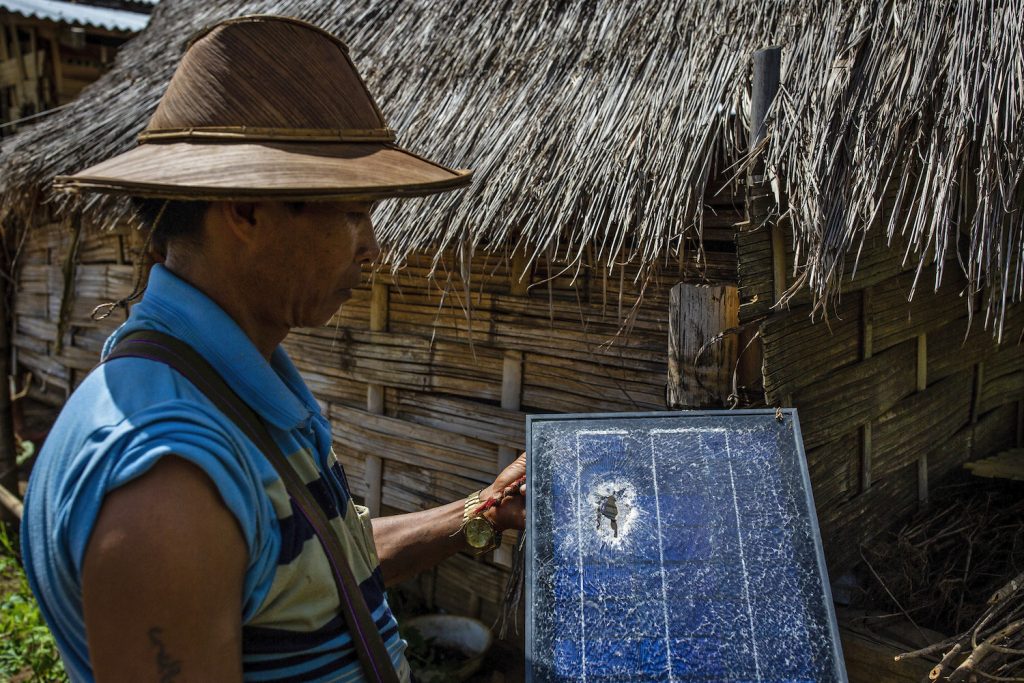
The Tatmadaw has a poor track record on holding itself accountable, and the alleged approach of its investigation team has also created controversy in Kyaukme. Civilians who were present when the killing occurred, including Nang Shwe, Nai Hsai and Maung Khay, have not been interviewed by the team.
This is at least partly out of fear. Pang Kyin residents claim the team sent an advance guard of soldiers into the village before its visit on July 15, which resulted in the recently traumatised villagers fleeing again. When the team itself arrived, there were no civilians left to interview. Meanwhile, the RCSS allegedly shot at the convoy.
Shan Hluttaw MP Sai Htun Win (Shan Nationalities League for Democracy, Kyaukme-1) was among those who did speak to the team, but said he felt its members were more interested in intimidating than investigating.
He said the investigators asked why he reported the incident to the Myanmar National Human Rights Commission. “We promised the witnesses we would report it,” he said, again calling for the MNHRC to investigate instead. “The Tatmadaw doesn’t cooperate or show transparency.”
During Frontier’s visit, Pang Kyin was a picture of pastoral tranquility. The fields were bursting with vibrant greenery, water buffaloes wallowed in muddy pools and young children played on the dirt roads.
But as villagers guided us through the town, they stopped every few minutes to point out more bullet holes. There were bullet holes in wooden fences, metal roofs, and concrete stoops – a constant reminder of the recent violence and the threat of more to come.
“If they come once, they usually come often in an attempt to claim the area,” said Htun Win. “They could come again soon.”


